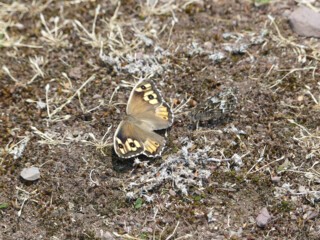Butterfly Effect
Quentin Shaw
For most of my life I thought the grayling was a fish, which it is, but it is also an obscure species of British butterfly. It lives on barren hilltops and sea cliffs, out of the public eye, shielded by a rather boring name. Until recently, when it has become clear that the grayling is in catastrophic decline.
Since 1976, grayling abundance has plunged by 72 per cent and distribution by 92 per cent. The butterfly has disappeared from half the sites where it previously bred. Its status has been upgraded from Vulnerable to Endangered, and Butterfly Conservation has funded projects to protect its habitat, a challenge when it isn’t entirely clear what has gone wrong. The most likely culprit is ammonia from intensive chicken farms: dissolved ammonia turns rain into a mild fertiliser, overgreening the sparse hilltop grassland that the grayling needs. For the last two years a group of volunteers have worked on my local hill cutting back the bramble and bracken encroaching on the bare summit, in the hope that we were making a difference.
In July the national experts arrived to inspect our work. Before we had even set off, they broke the bad news: on the Malvern Hills, despite a massive conservation effort, no butterflies have been seen this summer. They have become locally extinct. This leaves only two breeding sites in the West Midlands, and our hill is one of them. My heart sank. I had not seen a grayling on our hill this year.
But then the sun came out and as we walked up the hill someone pointed out that someone else had a grayling on their cardigan. Suddenly they were everywhere: orange-brown flashes flicking around our heads. They are obvious when flying, but when they land they disappear as if in a puff of smoke. Stephen Lewis showed me how they do it: they fold their bright forewings inside their camouflaged rear wings, then angle themselves to the sun to cast no shadow. A bright butterfly is instantly replaced by something that looks like a flake of lichen on the bare rock. The effect is mesmerising, like watching the marbled endpapers of an antiquarian book disappear between plain cloth covers.
Angling across the sun on warm rock allows a male to raise his temperature and supercharge his metabolism before challenging other males to a lek, a competitive display in which they spiral higher and higher before returning to defend their patches of bare rock and sheep’s fescue grass. Impressed females may then choose whoever went highest as a mate and use his scruffy brown grass to lay their eggs. Between episodes of intense activity, the butterflies dash down the slope to refuel on nectar from the bramble flowers which we had so recently been slashing back. What may seem like a life of random fluttering at the mercy of the wind is in fact wilful, sophisticated behaviour.
The team were trying to work out exactly what qualities of microhabitat the females chose as egg sites. To our surprise they selected very barren patches in the middle of eroded footpaths. The hatching caterpillars will need to overwinter by hiding in the roots of the fescue, passing through four instar stages before appearing as butterflies next summer.
At the end of their short summer season the surviving graylings will set off in small groups for a final flight south, a sort of pseudo-migration. As with so many aspects of their secretive lifestyle, it isn’t clear why they do this. By then their wings will be tattered and their metabolism burnt out. They won’t survive the autumn. But the Malvern Hills are just sixty kilometres south of here. Perhaps one or two of the females will carry their last few eggs and lay them there before they die.
